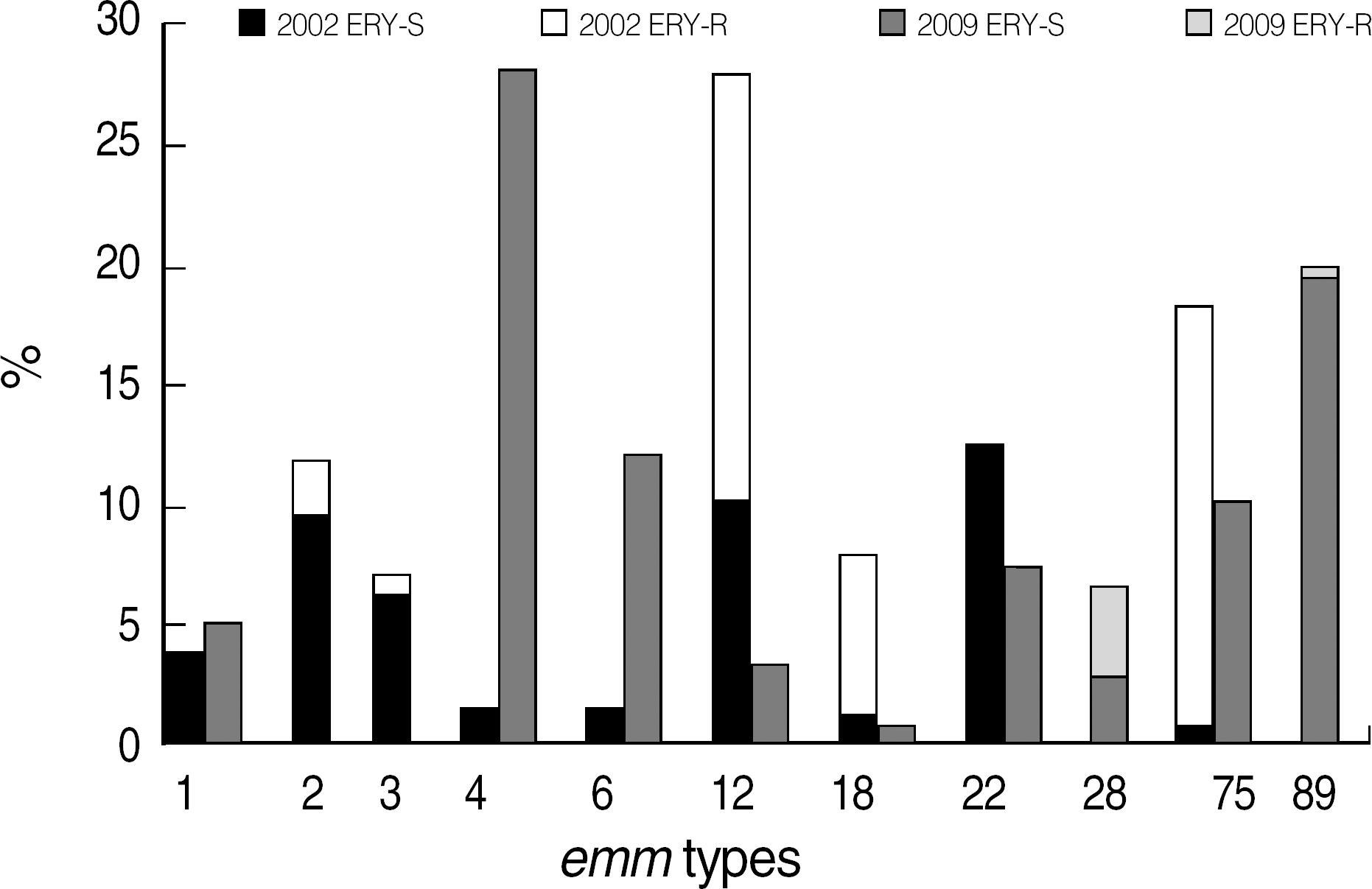Abstract
Background:
Group A streptococcus (GAS) is the most common cause of bacterial pharyngitis in children. Antibiotic resistance rates and emm genotypes of GAS isolated from patients with acute pharyngitis were studied in 2009.
Methods:
Throat cultures were taken from 499 children with acute pharyngitis in Jinju, Korea, in 2008-2009. A total of 174 strains (34.9%) of GAS were isolated, and antimicrobial susceptibility testing was performed using the disk diffusion method. The phenotypes of macrolide resistance and macrolide resistance genes were determined. The emm genotypes were identified using PCR and sequencing. The data were compared with those acquired in 2002 in the same region. Data on the annual macrolide production were collected between 1999 and 2008.
Results:
The resistance rates of GAS to erythromycin, clindamycin, and tetracycline were 4.6%, 2.9%, and 2.3%, respectively. The constitutive resistance rate was 62.5% for the erm(B) gene and 37.5% for the M phenotype of the mef(A) gene. emm4 was most frequently detected (28.2%), followed by emm89 (20.1%). Most of the erythromycin resistant strains had the emm28 genotype. We noted a gradual increase in macrolide production during the study period.
Conclusions:
The erythromycin resistance rate of GAS isolated from children with acute pharyngitis was significantly lower in 2009 (4.6%) than in 2002 (44.8%). We observed a remarkable change in the distribution of emm genotypes during the 7-yr period. The significant decline in erythromycin resistance in 2009 might be associated with a prominent decrease in the resistant genotype emm12 (3.4% in 2009 vs. 28.0% in 2002) rather than restriction of macrolide use.
REFERENCES
1.Cunningham MW. Pathogenesis of group A streptococcal infections. Clin Microbiol Rev. 2000. 13:470–511.

2.Imohl M., Reinert RR., Ocklenburg C., van der Linden M. Epidemiology of invasive Streptococcus pyogenes disease in Germany during 2003-2007. FEMS Immunol Med Microbiol. 2010. 58:389–96.
3.Tilanus AM., de Geus HR., Rijnders BJ., Dwarkasing RS., van der Hoven B., Bakker J. Severe group A streptococcal toxic shock syndrome presenting as primary peritonitis: a case report and brief review of the literature. Int J Infect Dis. 2009. ;Epub ahead of print.

4.Bisno AL., Stevens DL. Streptococcal infections of skin and soft tissues. N Engl J Med. 1996. 334:240–5.

5.Michos AG., Bakoula CG., Braoudaki M., Koutouzi FI., Roma ES., Pangalis A, et al. Macrolide resistance in Streptococcus pyogenes: prevalence, resistance determinants, and emm types. Diagn Microbiol Infect Dis. 2009. 64:295–9.
6.Bingen E., Bidet P., Mihaila-Amrouche L., Doit C., Forcet S., Brahimi N, et al. Emergence of macrolide-resistant Streptococcus pyogenes strains in French children. Antimicrob Agents Chemother. 2004. 48:3559–62.
7.Green MD., Beall B., Marcon MJ., Allen CH., Bradley JS., Dashefsky B, et al. Multicentre surveillance of the prevalence and molecular epidemiology of macrolide resistance among pharyngeal isolates of group A streptococci in the USA. J Antimicrob Chemother. 2006. 57:1240–3.

8.Perez-Trallero E., Montes M., Orden B., Tamayo E., Garcia-Arenzana JM., Marimon JM. Phenotypic and genotypic characterization of Streptococcus pyogenes isolates displaying the MLSB phenotype of macrolide resistance in Spain, 1999 to 2005. Antimicrob Agents Chemother. 2007. 51:1228–33.
9.Liu X., Shen X., Chang H., Huang G., Fu Z., Zheng Y, et al. High macrolide resistance in Streptococcus pyogenes strains isolated from children with pharyngitis in China. Pediatr Pulmonol. 2009. 44:436–41.
10.Koo HK., Baek SC., Ma SH., Lee HJ., Cha SH. Trends of incidence of erythromycin-resistant group A streptococci in Korea from 1998 through 2002. Infect Chemother. 2004. 36:75–82.
11.Reinert RR., Lutticken R., Bryskier A., Al-Lahham A. Macrolide-resistant Streptococcus pneumoniae and Streptococcus pyogenes in the pediatric population in Germany during 2000-2001. Antimicrob Agents Chemother. 2003. 47:489–93.
12.Beall B., Facklam R., Thompson T. Sequencing emm-specific PCR products for routine and accurate typing of group A streptococci. J Clin Microbiol. 1996. 34:953–8.
13.Creti R., Imperi M., Baldassarri L., Pataracchia M., Recchia S., Alfarone G, et al. emm types, virulence factors, and antibiotic resistance of invasive Streptococcus pyogenes isolates from Italy: what has changed in 11 yr? J Clin Microbiol. 2007. 45:2249–56.
14.Grivea IN., Al-Lahham A., Katopodis GD., Syrogiannopoulos GA., Reinert RR. Resistance to erythromycin and telithromycin in Streptococcus pyogenes isolates obtained between 1999 and 2002 from Greek children with tonsillopharyngitis: phenotypic and genotypic analysis. Antimicrob Agents Chemother. 2006. 50:256–61.
15.Koh EH., Kim S., Lee NY. Decrease of erythromycin resistance in group A streptococci by change of emm distribution. Jpn J Infect Dis. 2008. 61:261–3.
16.Kim S., Yong Lee N. Antibiotic resistance and genotypic characteristics of group A streptococci associated with acute pharyngitis in Korea. Microb Drug Resist. 2004. 10:300–5.

17.Yi YH., Choi JH., Lee HK., Lee KJ., Bae SM., Yu JY, et al. Characterization of erythromycin resistance of Streptococcus pyogenes isolated from pharyngitis patients in Korea. Jpn J Infect Dis. 2006. 59:192–4.
18.Bergman M., Huikko S., Pihlajamaki M., Laippala P., Palva E., Huovinen P, et al. Effect of macrolide consumption on erythromycin resistance in Streptococcus pyogenes in Finland in 1997-2001. Clin Infect Dis. 2004. 38:1251–6.
19.Fujita K., Murono K., Yoshikawa M., Murai T. Decline of erythromycin resistance of group A streptococci in Japan. Pediatr Infect Dis J. 1994. 13:1075–8.

20.Ardanuy C., Domenech A., Rolo D., Calatayud L., Tubau F., Ayats J, et al. Molecular characterization of macrolide- and multidrug-resistant Streptococcus pyogenes isolated from adult patients in Barcelona, Spain (1993-2008). J Antimicrob Chemother. 2010. 65:634–43.
Fig. 1.
Distribution of emm types of ERY-resistant and ERY-susceptible strains in 2002 and 2009. P<0.05.
Abbreviations: 2002 ERY-S and 2002 ERY-R, erythromycin-susceptible and -resistant in 2002; 2009 ERY-S and 2009 ERY-R, erythromycin-susceptible and -resistant in 2009.

Table 1.
Comparison of antibiotic resistance rates and macrolide resistance phenotypes of group A streptococci between 2002 and 2009 in Jinju, Korea
Table 2.
Comparison of emm types of group A streptococci isolated from children with acute pharyngitis between 2002 and 2009
Table 3.
The production cost of macrolides between 1999-2008∗




 PDF
PDF ePub
ePub Citation
Citation Print
Print


 XML Download
XML Download